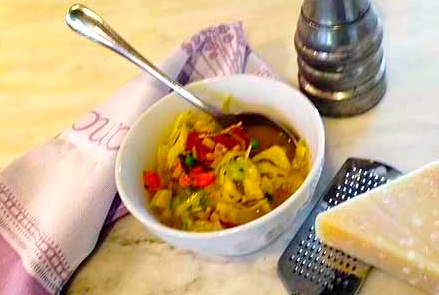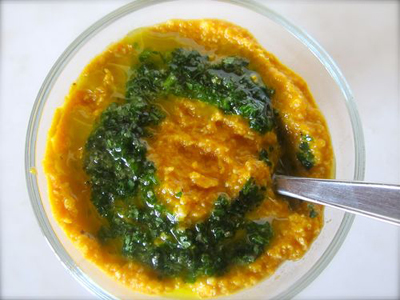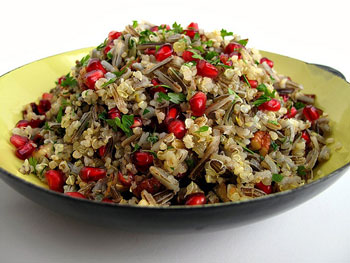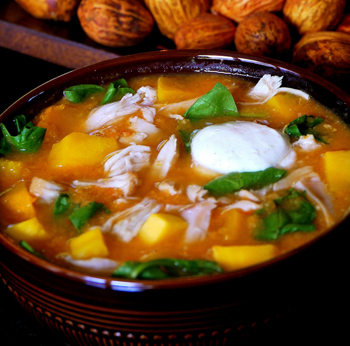 Velvety smooth, thick and creamy, soft and spreadable, sweet and tart — all characteristics of a good lemon curd. Every year around this time, I pull out my favorite recipe for lemon curd. Last week, I adapted that recipe to create a mouth-watering bowl of mango curd. A kiss of citrus from lemon and lime juices gives this creamy tropical curd just enough tartness to balance the sweet-as-honey mango.
Velvety smooth, thick and creamy, soft and spreadable, sweet and tart — all characteristics of a good lemon curd. Every year around this time, I pull out my favorite recipe for lemon curd. Last week, I adapted that recipe to create a mouth-watering bowl of mango curd. A kiss of citrus from lemon and lime juices gives this creamy tropical curd just enough tartness to balance the sweet-as-honey mango.
Spread this Mango Curd on scones, banana muffins or bran muffins. Use it to fill tiny tarts or little thumbprint cookies. Sandwich it between butter cookies or spread it on shortbread.
Mango Curd is quite sublime with Tropical Mango Baby Cakes. I baked the cake batter in mini-bundt pans. The next batch of batter was baked in traditional cupcake tins. The cupcakes can be cut through the middle to form two layers. The Mango Curd is a perfect filling. Sprinkle the little cakes with powdered sugar and they are ready to eat.

 So far I have stuck to my New Year’s resolutions except for the part about the peppermint bark. I resolved to eat nothing but healthy foods and have done so religiously since December 31st–except for the peppermint bark. I just gave the peppermint bark (what was left of it) to Aunt Christina so now I am totally on track.
So far I have stuck to my New Year’s resolutions except for the part about the peppermint bark. I resolved to eat nothing but healthy foods and have done so religiously since December 31st–except for the peppermint bark. I just gave the peppermint bark (what was left of it) to Aunt Christina so now I am totally on track. Pop Quiz: What makes two people's three dinners, two lunches, and fills a whole leftover Martha Stewart BPA-free glassware? The answer, my friends, is Italian Wedding Soup. You didn't hear it from me, but this stuff fulfills all the food groups, ensures your fill of kale for a day, and pumps you up full of vitamins. And, it's delicious.
Pop Quiz: What makes two people's three dinners, two lunches, and fills a whole leftover Martha Stewart BPA-free glassware? The answer, my friends, is Italian Wedding Soup. You didn't hear it from me, but this stuff fulfills all the food groups, ensures your fill of kale for a day, and pumps you up full of vitamins. And, it's delicious. It always amazes me how a handful of ingredients can come together in such stunning ways. Take carrots and raw cashews. Who knew? Combining them with some chicken broth resulted in an extraordinarily different kind of soup. It is creamy and light as a cloud at the same time. Neither liquid nor broth, but more of a puree with texture.
It always amazes me how a handful of ingredients can come together in such stunning ways. Take carrots and raw cashews. Who knew? Combining them with some chicken broth resulted in an extraordinarily different kind of soup. It is creamy and light as a cloud at the same time. Neither liquid nor broth, but more of a puree with texture.  Stuffing, mashed potatoes, sweet potato casserole, green bean casserole. Most people will say that Thanksgiving isn't a holiday without these traditional dishes, but that doesn't have to be the case. Although they are classics, it doesn't mean they can't be reinterpreted, reimagined, or replaced with an equally interesting seasonal side dish. When vegetarians are around, it's also courteous to keep them in mind when planning the menu.
Stuffing, mashed potatoes, sweet potato casserole, green bean casserole. Most people will say that Thanksgiving isn't a holiday without these traditional dishes, but that doesn't have to be the case. Although they are classics, it doesn't mean they can't be reinterpreted, reimagined, or replaced with an equally interesting seasonal side dish. When vegetarians are around, it's also courteous to keep them in mind when planning the menu.
